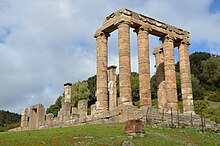Temple of Antas
 The Temple of Antas. | |
| Lua error in Module:Location_map at line 526: Unable to find the specified location map definition: "Module:Location map/data/Italy Sardegna" does not exist. | |
| Alternative name | Tempio di Antas |
|---|---|
| Type | Monument |
| History | |
| Cultures | Punic civilization Roman civilization |
| Site notes | |
| Excavation dates | yes |
| Condition | ruined |
| Management | I Beni Culturali della Sardegna |
| Public access | yes |
| Website | Sassari, Fluminimaggiore, tempio di Antas Template:It icon |
The Temple of Antas is an ancient Carthaginian-Roman temple in the commune of Fluminimaggiore, southern Sardinia, Italy.[1] It is located in an area colonised by the Carthaginians and then by the Romans, attracted by its iron and lead deposits.[2]
It consists of a Roman temple, under whose steps are the remains of the Carthaginian one, which was dedicated to the god Sid Addir, a later incarnation of the local god Sardus Pater Babai, the main male divinity of the Nuragic civilization.
The original temple had been built around 500 BC over a sacred limestone outcrop, and restored around 300 BC. The Roman temple was built by emperor Augustus (27 BC - 14 AD) and restored under Caracalla (213-217 AD). Its remains were discovered in 1836 by general Alberto La Marmora, and rebuilt to the current status in 1967.[3]
The fore section of the temple includes six columns, with a height of some 8 metres, with Ionic capitals. Originally a triangular pediment was also present. The cella was accessed through two side openings and had a mosaic-covered pavement, part of which has been preserved. The temple was provided with two square reservoirs, which housed the water for the sacred rites of purification.
It is likely that a statue of the Sardus Pater was housed in the cella. According to the size of the only remain found, a finger, it has been estimated that it was some 3 metres high.
The archaeological area of temple includes a small necropolis, remains of an ancient Nuragic village (13th-10th centuries BC), Roman quarries of limestone and an ancient path connecting the temple to a sacred cave where the water cult was practised.
External links
- Italian page about the temple Template:It icon
- Sassari, Fluminimaggiore, tempio di Antas Template:It icon
References
- ^ Dyson, S., DARMC, R. Talbert, S. Gillies, T. Elliott, J. Becker. "Places: 471971 (Metalla)". Pleiades. Retrieved January 3, 2015.
{{cite web}}: CS1 maint: multiple names: authors list (link) - ^ Logus-Mezzolani (21 July 2012). Archeologia della Sardegna. Logus. pp. 24–. ISBN 978-88-98062-00-3.
- ^ Raimondo Zucca (1989). Il Tempio di Antas. Carlo Delfino.
